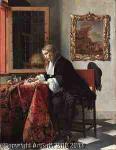Gabriel Metsu
- Sanatçı
- Tüm yapıtları izle Kronolojik
- Alfabe bütün yapıtları izle
- Konuya göre sanat eserleri
- Öne çıkan sanat

stil: Baroque;
yer: Leiden
Doğmuş: 1629
Ölüm: 1667
Biyografi:
Gabriël Metsu (1629–1667) was a Dutch painter of history paintings, still lifes, portraits, and genre works. He was "a highly eclectic artist, who did not adhere to a consistent style, technique, or one type of subject for long periods." Only 14 of his 133 works are dated. Gabriel Metsu was the son of Jacques Metsu (c. 1588 – March 1629) a tapestry...
Wikipedia link: Click Here